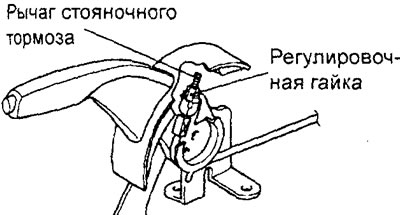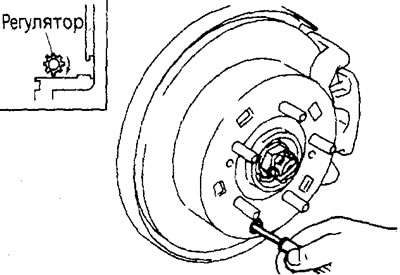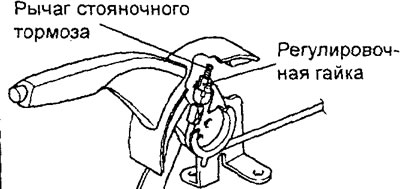Note: On vehicles with rear drum brakes, the parking brake function is performed by the drum brake.
Checks and adjustments
Checking the stroke of the parking brake lever
1. Pull the parking brake lever with a force of approximately 200 N and count the number of clicks until it locks.
Rated value - 5-7 clicks
Attention: when checking, make sure that the force on the parking brake lever corresponds to the value indicated above.
2. If the amount of travel of the parking brake lever does not correspond to the nominal value, then make the appropriate adjustment.
Parking brake lever stroke adjustment (models with rear disc brakes with drum parking brake)
1. Remove the lower part of the center console (see chapter "Body").
2. Loosen the parking brake cable by loosening the adjusting nut shown in the figure.

3. Remove rear wheels.
4. Remove the plug from the technological hole in the rear brake support shield and, turning the adjuster (in the direction indicated by the arrow) Using a flathead screwdriver, spread the brake pads so that the brake disc does not rotate.
5. Turn the knob clockwise 5 clicks.

6. Turn the adjusting nut to adjust the parking brake lever stroke so that it is within the nominal value.
Attention: if the amount of travel of the parking brake lever is less than the nominal value and the gap between the brake pad and the brake disc is too small, then the rear brakes may seize.
7. After completing the adjustment, check that there is no gap between the adjusting nut and the parking brake lever.
8. After adjusting the parking brake lever travel, jack up the rear of the vehicle.
9. Lower the parking brake lever all the way down and, while rotating the rear wheels, make sure that the rear brakes do not stick (parking brake).
10. Install the bottom of the center console (see chapter "Body").
Parking brake lever stroke adjustment (models with rear drum brakes)
1. Remove the lower part of the center console (see chapter "Body").
2. Loosen the parking brake cable tension by loosening the adjusting nut.
3. While the engine is idling, depress the brake pedal hard two or three times. At the same time, make sure that the amount of pedal travel has ceased to change.
Note: If the amount of pedal travel does not change, this indicates that the automatic gap adjustment mechanism is functioning normally and the required gap between the brake shoes and the brake drum is set.
4. Rotate the adjusting nut to adjust the travel of the parking brake lever so that it is within the nominal value.
Attention: if the amount of travel of the parking brake lever is less than the nominal value, then this will increase the extension of the cable. Make sure the lever travel is adjusted correctly.
5. After completing the adjustment, check that there is no gap between the adjusting nut and the parking brake lever.
6. After adjusting the parking brake lever travel, jack up the rear of the vehicle.
7. Lower the parking brake lever down to the stop and, rotating the rear wheels, make sure that the rear brakes do not stick (parking brake).
8. Install the bottom of the center console (see chapter "Body").
Checking the parking brake indicator switch
1. Remove the bottom of the center console and the driver's seat (see chapter "Body").
2. Connect an ohmmeter between the switch terminal and the switch mounting bolt and measure the resistance.
3. The parking brake indicator switch is OK if the switch circuit is closed when the parking brake lever is raised, and when the parking brake lever is lowered (down position) - the circuit is open.

4. Install the driver's seat and the lower part of the center console in place (see chapter "Body").
Running in of friction linings
ToNote: Burn-in is carried out after replacing the brake pads or brake disc, or when the parking brake is not working reliably.
Attention: run-in friction linings on the road, provided there is sufficient visibility and no obstructions. Take the necessary safety measures to avoid an emergency.
1. Adjust the travel of the parking brake lever.
2. Attach a dynamometer to the center of the parking brake lever handle and pull the lever with a force of 100-150 N in a direction perpendicular to the lever.

3. Drive the car for about 100 meters at a constant speed of 35-50 km/h.
4. Release the parking brake lever and wait 5-10 minutes for the brake disc to (models with rear disc brakes) or brake drum (models with rear drum brakes) cooled down.
5. Repeat the procedures in paragraphs. "2"-"4" four or five times.
